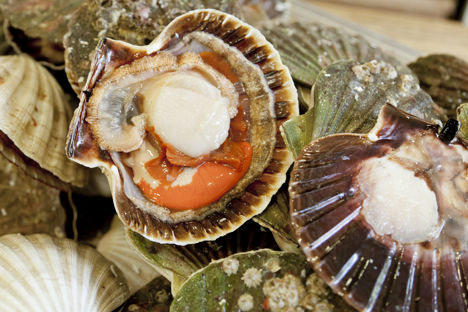Scallops are hermaphrodite bivalve molluscs with a delectably sweet and juicy taste. They are high in protein and low in calories, also containing Omega-3 fatty acids, magnesium, potassium and B12, which help to maintain a healthy nervous system, as well as tryptophan, an amino acid that aids sleep.
Scallops are cold water shellfish that grow in all of the world’s oceans. In the UK, we eat king scallops, the smaller queen (also known as queenies) and petite princess scallops. They’re sourced mainly around Cornwall, Scotland and the Isle of Man, where there’s an annual queenie festival.
What to look for when buying scallops
The status of wild scallops is currently under review. Even though they are more expensive it’s better to buy scallops hand-caught by divers rather than dredged, as this method has been criticised for damaging seabeds, and scallops fished this way can contain more grit.
You’ll find both fresh and frozen scallops in supermarkets but it’s prudent to buy scallops from a reputable fishmonger or online supplier. One unsavoury practice is to soak them to increase their weight. Scallops should smell fresh like the sea – if they have a fishy odour don’t buy them – and look firm, opaque and moist. If you’re buying scallops still in their shells try to buy them alive; shells should be tightly but not completely shut (the corrugated pattern prevents this).
Scallops will keep in the fridge for up to two days but are best eaten on the day of purchase.
How to cook scallops
To shuck scallops (prise the shells apart), use a shucking knife, a sharp knife to release the meat. Discard the attached muscle, skirt and black stomach sack. Inside, you will also find a vivid orange roe (also called coral), which is often discarded but is actually edible. Rinse (don’t drench) several times in cold water to remove sand or grit.
Once shucked, scallops can be cooked. Scallops take just a few minutes to steam, poach or pan-fry, and baking doesn’t take much longer. Because scallops require minimal cooking, searing or pan-frying them is often the most suitable method as it adds colour without overcooking. They become tough and rubbery if overcooked.
When cooking scallops remember to pat dry and don't overcrowd the pan. You are aiming for a caramelised crust and a slightly translucent centre (you can see this by checking the side). A general rule of thumb is 2 minutes on one side and anything from 10 seconds to 2 minutes on the other. If scallops are mushy to the touch, they’re undercooked; if they’re firm, they’re overcooked. If, however, they’re springy, congratulations; you’ve just cooked the perfect scallop.
Cooking en-papillote is a great way to cook scallops to hold in moisture, creating luscious morsels, often cooked in stock, water, milk, white wine or alcohol such as Noilly Prat.
For a twist on fish and chips use a traditional beer batter to deep-fry scallops. Tempura scallops are also well worth a try; the lightness of the batter won’t engulf their understated taste. If you’re feeling creative, marinate then wrap scallops in strips of wonton wrappers and fry. Scallops can also be served raw or barely cooked, serving as sashimi, carpaccio or ceviche to highlight their sweet tender flavour. Scallop ceviche is 'cooked' in an acidic marinade by a process call denaturing. But if making at home it is important to only use the freshest scallops.
Get in touch
Please sign in or register to send a comment to Great British Chefs.



